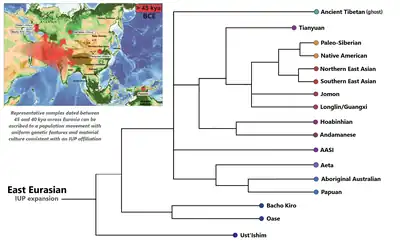| Tianyuan man | |
|---|---|
.png.webp) 50,000~40,000 BP ◇ ▷ Tianyuan man and contemporary cultures c. 50,000~40,000 |
Tianyuan man (simplified Chinese: 田园洞人; traditional Chinese: 田園洞人; pinyin: Tiányuándòng Rén) are the remains of one of the earliest modern humans to inhabit East Asia. In 2007, researchers found 34 bone fragments belonging to a single individual at the Tianyuan Cave near Beijing, China.[1][2] Radiocarbon dating shows the bones to be between 42,000 and 39,000 years old, which may be slightly younger than the only other finds of bones of a similar age at the Niah Caves in Sarawak on the South-east Asian island of Borneo.
Subsistence
Nothing is known directly about the material culture of this individual, since so far no artifacts or other cultural remains have been found at the site.[2] Isotope analysis suggests that a substantial part of his diet came from freshwater fish.[3]
Physical anthropology

Morphology
Tianyuan man is considered an early modern homo sapiens. He lacks several mandibular features common among western Eurasian late archaic humans, showing its divergence. Based on the rate of dental occlusal attrition, it is estimated he died in his 40s or 50s.[2]
Genetics
The first DNA analysis of the Tianyuan remains (focussing on mtDNA and chromosome 21) was published in 2013 and revealed that Tianyuan man is related "to many present-day Asians and Native Americans" and had already diverged genetically from the ancestors of modern Europeans.[4] He belonged to mitochondrial DNA haplogroup B.[4]
A genome-wide analysis confirmed the close affinity of Tianyuan man to modern East Asian and Southeast Asians, but also showed that he is not directly ancestral to modern populations, but rather represents a deeply diverged member of the East and Southeast Asian (ESEA) lineage, basal to all later populations of East and Southeast Asia.[5][6][7]
Tianyuan man exhibits a unique genetic affinity for GoyetQ116-1 from the Goyet Caves in Namur province, Belgium. GoyetQ116-1 shares more alleles with Tianyuan man than does any other sampled ancient individual from West Eurasia.[5]
The Tianyuan man was determined to be part of an Initial Upper Paleolithic wave (>45kya) "ascribed to a population movement with uniform genetic features and material culture" (Ancient East Eurasians), and sharing deep ancestry with other ancient specimens such as Bacho Kiro, Peștera cu Oase, the Ust'-Ishim man, as well as the ancestors of modern day Papuans (Australasians).[8]
Basal East Asian or "Deep Asian" ancestry represented by Tianyuan or Andamanese Onge contributed to the Peopling of Southeast Asia, following Australasian ancestry and preceding Mesolithic and Neolithic expansions of Ancient Southern East Asians associated with the spread of Austroasiatic and Austronesian languages.[9]
References
- ↑ "Ancient human unearthed in China". BBC News. 2 April 2007. Retrieved 26 February 2011.
- 1 2 3 Shang, Hong (2007). "An early modern human from Tianyuan Cave, Zhoukoukian, China". Proceedings of the National Academy of Sciences. 104 (16): 6573–8. Bibcode:2007PNAS..104.6573S. doi:10.1073/pnas.0702169104. PMC 1871827. PMID 17416672.
- ↑ Hu, Y.; Shang, H.; Tong, H.; Nehlich, O.; Liu, W.; Zhao, C.; Yu, J.; Wang, C.; Trinkaus, E.; Richards, M. (2009). "Stable isotope dietary analysis of the Tianyuan 1 early modern human". Proceedings of the National Academy of Sciences. 106 (27): 10971–10974. Bibcode:2009PNAS..10610971H. doi:10.1073/pnas.0904826106. ISSN 0027-8424. PMC 2706269. PMID 19581579.
- 1 2 Fu, Q.; Meyer, M.; Gao, X.; Stenzel, U.; Burbano, H.A.; Kelso, J.; Pääbo, S. (2013). "DNA analysis of an early modern human from Tianyuan Cave, China". Proceedings of the National Academy of Sciences. 110 (6): 2223–2227. Bibcode:2013PNAS..110.2223F. doi:10.1073/pnas.1221359110. PMC 3568306. PMID 23341637.
- 1 2 Yang, Melinda A.; Gao, Xing; Theunert, Christoph; Tong, Haowen; Aximu-Petri, Ayinuer; Nickel, Birgit; Slatkin, Montgomery; Meyer, Matthias; Pääbo, Svante; Kelso, Janet; Fu, Qiaomei (2017). "40,000-Year-Old Individual from Asia Provides Insight into Early Population Structure in Eurasia". Current Biology. 27 (20): 3202–3208.e9. doi:10.1016/j.cub.2017.09.030. ISSN 0960-9822. PMC 6592271. PMID 29033327.
- ↑ Zhang, Ming; Fu, Qiaomei (2020). "Human evolutionary history in Eastern Eurasia using insights from ancient DNA". Current Opinion in Genetics & Development. Genetics of Human Origin. 62: 78–84. doi:10.1016/j.gde.2020.06.009. ISSN 0959-437X. PMID 32688244. S2CID 220671047.
- ↑ Yang, Melinda A. (2022). "A genetic history of migration, diversification, and admixture in Asia". Human Population Genetics and Genomics. 2 (1): 1–32. doi:10.47248/hpgg2202010001. ISSN 2770-5005.
...the ESEA lineage differentiated into at least three distinct ancestries: Tianyuan ancestry which can be found 40,000-33,000 years ago in northern East Asia, ancestry found today across present-day populations of East Asia, Southeast Asia, and Siberia, but whose origins are unknown, and Hòabìnhian ancestry found 8,000-4,000 years ago in Southeast Asia, but whose origins in the Upper Paleolithic are unknown.
- ↑ "Genetics and Material Culture Support Repeated Expansions into Paleolithic Eurasia from a Population Hub Out of Africa". academic.oup.com. Retrieved 10 November 2023.
- 1 2 Kusuma, Pradiptajati; Cox, Murray P.; Barker, Graeme; Sudoyo, Herawati; Lansing, J. Stephen; Jacobs, Guy S. (1 November 2023). "Deep ancestry of Bornean hunter-gatherers supports long-term local ancestry dynamics". Cell Reports. 42 (11): 113346. doi:10.1016/j.celrep.2023.113346. ISSN 2211-1247. PMID 37917587.